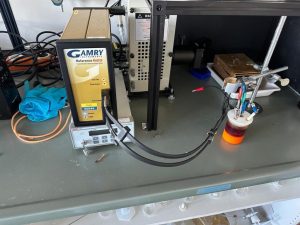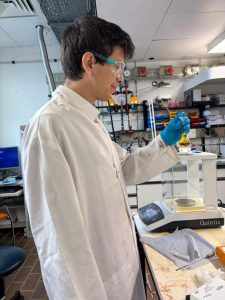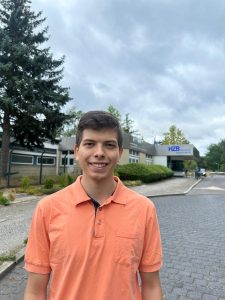
By summerstudent Felipe Mata Mata >
I study the oxygen evolution reaction (OER). If you’re wondering what that is and why anyone would bother with it, let me explain: The OER is a crucial step in water electrolysis – Yes, think back to your chemistry classes at school! Water is made of two hydrogen atoms and one oxygen atom, and splitting it has become a hopeful way to produce clean fuels. By using sunlight or wind to supply the necessary voltage, we can generate hydrogen without relying on fossil fuels, this is known as green hydrogen. That’s a big step toward sustainable energy using the chemistry!
So, what do I actually do in the lab?

I work on preparing some films to optimize the OER with an specific material bismuth vanadate (BiVO4) . The process starts by synthesizing an adapt solution, which I then deposit onto an FTO (fluorine-doped tin oxide) film through electrodeposition. FTO is a special type of glass where one side is conductive due to a thin coating of the conductive material. Electrodeposition involves using an electrical circuit to deposit material onto the conductive surface.
In my experiments, this process is controlled by a potentiostat and galvanostat, which is relatively easy to operate. The potentiostat is used by a sequence of several processes activating the electrical circuit and allows the deposition. Afterwards, we can take out the film, and its coated of the deposited material, in my case, bismuth oxyiodide. Then, I drop a vanadium-containing solution onto the film and heat it in a furnace. This final step converts the surface into bismuth vanadate, the material we are studying for its promising photoelectrochemical properties.
How’s it going?
 The first time I did this, it went terribly, the deposits were hardly visible, and sometimes there were even “holes” in the films with no material at all. But as you know, experience makes you better. Now, I’m getting much better results: more uniform films, just the way we want them! Even though I haven’t done everything perfectly, like the time I couldn’t get into the lab because I accidentally left the keys inside.
The first time I did this, it went terribly, the deposits were hardly visible, and sometimes there were even “holes” in the films with no material at all. But as you know, experience makes you better. Now, I’m getting much better results: more uniform films, just the way we want them! Even though I haven’t done everything perfectly, like the time I couldn’t get into the lab because I accidentally left the keys inside.
By the way this experience has been incredible and absolutely worth it. Now, it’s time to keep learning and improving so I can bring back the knowledge to my country and share it with more peers, because that’s what science is all about!!

About the author: Felipe Mata Mata is working with the Oxygen Evolution Mechanism Engineering Group (CE-NOME). He is involved in the study of the oxygen evolution reaction by improving BiVO4 photoanodes in alkaline media, under the supervision of Dr. Maddalena Zoli. Felipe is an undergraduate student in Physics and Electrical Engineering at the University of Costa Rica. Additionally, he is studying an undergraduate degree in Mechatronic Engineering at the Costa Rica Institute of Technology.
